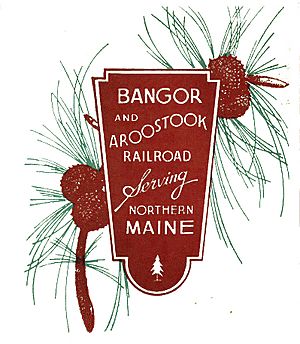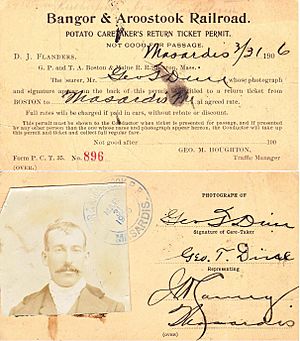Bangor and Aroostook Railroad facts for kids
 |
|

The railroad's Aroostook Flyer passenger train, c. 1950s
|
|
| Overview | |
|---|---|
| Headquarters | Bangor, Maine |
| Reporting mark | BAR |
| Locale | Maine |
| Dates of operation | 1891–2003 |
| Successor | Montreal, Maine and Atlantic Railway |
| Technical | |
| Track gauge | 4 ft 8 1⁄2 in (1,435 mm) |
The Bangor and Aroostook Railroad (BAR) was a railroad company in the United States. It brought train service to Aroostook County in northern Maine. In the 1950s, BAR's brightly painted boxcars became famous across the country.
The railroad used its first diesel locomotives for a very long time. They even ran until they were old enough for museums! In the 1980s, the economy slowed down. Many big factories left northern Maine. This made the railroad look for a buyer. It stopped running in 2003. The Montreal, Maine and Atlantic Railway took over its lines.
Contents
A Railroad's Journey: History of BAR

The Bangor and Aroostook Railroad company started in 1891. It combined two older train lines. Its main office was in Bangor. By 1894, its tracks reached Oakfield and Houlton. Over the next few years, the lines grew. They reached towns like Caribou, Van Buren, and Fort Kent.
In 1905, the railroad extended south to Searsport. This town is on Penobscot Bay. In 1910, tracks went along the Saint John River to St. Francis. An international bridge was built in 1915. It connected Van Buren, Maine, to St. Leonard, New Brunswick, Canada. This linked BAR with Canadian railroads.
Potatoes and Paper: Key Cargo
BAR started moving potatoes in special heated boxcars in 1895. Potatoes were a very important crop for Maine. They provided a steady income for the railroad. Even during the Great Depression, potatoes helped the BAR. After World War II, potatoes made up half of the railroad's money.
BAR had the second-largest fleet of reefer cars in the U.S. These cars kept food cold. They worked with another railroad to ship potatoes in winter. Then, they carried California produce in summer.
In the 1960s, more potatoes started moving by truck. This was because new highways were built. A big problem happened in 1969-1970. Another railroad's service was very bad. Many potato cars froze because their heaters ran out of fuel. This caused many potato farms to close. The farms that survived stopped trusting train service.
Paper mills were also very important for the BAR. They shipped chemicals to the mills. They also shipped paper from the mills. Mills in Millinocket and East Millinocket were major customers. Another paper mill opened in Madawaska in 1925. Shipping wood to these mills became more important as potato business slowed.
Supporting the Military
During World War II, Searsport was a key place to load ammunition. BAR moved a lot of military supplies. During the Cold War, BAR carried heating coal and jet fuel. This fuel went to Loring AFB. It was used for Strategic Air Command bombers.
In the 1950s, BAR painted 2,500 boxcars. They were red, white, and blue, like the U.S. flag. Later, during the Vietnam War, they used a simpler red color. It had large white letters for the railroad's name.
Passenger Trains: A Look Back
Into the 1950s, the Bangor and Aroostook ran passenger trains. One popular train was the Aroostook Flyer. It ran in the afternoon from Bangor to Van Buren. Passengers could connect from other trains in Bangor.
Another morning train was called the Potatoland. It made local stops along the same route. After Van Buren, it continued west to St. Francis. BAR also offered service to Greenville. This connected with other Canadian trains.
End of Passenger Service
BAR stopped running passenger trains in 1961. However, they had started a bus service in 1936. These buses continued to run until 1984. They followed Greyhound Lines schedules. They traveled between Aroostook County and New York City.
Decline and New Owners
In 1995, a company called Iron Road Railways bought the BAR. But in 2002, the company went bankrupt. This means it could not pay its debts. The next year, its train lines were sold. A new company, Montreal, Maine & Atlantic Railway, took them over.
Later, parts of the line were sold again. In 2010, the state of Maine bought 133 miles of track. This section went from Millinocket north to the Canadian border. It is now operated by the Maine Northern Railway. The rest of the line, from Millinocket south to Searsport, was sold to another company. It is now part of the Central Maine and Quebec Railway. In 2019, the Canadian Pacific Railway bought this line. This helped them expand their service into New England.
Rolling Stock: The Trains and Cars
The Bangor and Aroostook Railroad owned many different steam locomotives over the years. Most were built by companies like Manchester Locomotive Works. Later, they started using diesel locomotives in the late 1940s. Types like the EMD GP7 and EMD GP38 were common.
The BAR also had some unusual EMD BL2 locomotives. These were special "branch line" engines. Many of these early diesel trains stayed in use for a very long time. They were still running when they were old enough to be in a museum! As mentioned before, their red, white, and blue boxcars were very famous in the 1950s.


